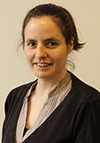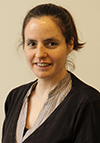Conducting a detailed workforce analysis for Cancer Research UK
20 Dec 2017

 Matthew Williams, Senior Research Fellow, and Clare Huxley, Research Fellow
Matthew Williams, Senior Research Fellow, and Clare Huxley, Research Fellow
Cancer Research UK (CRUK) recently published its report on the UK’s non-surgical oncology workforce which, for the first time, gives an overview of the current workforce delivering non-surgical treatments for cancer across the UK and provides projections for what this workforce may look like in five years’ time.
IES’ contribution to this project drew on our expertise in workforce research, such as our analysis of the UK’s nursing workforce on behalf of the Migration Advisory Committee in 2016. This research on behalf of CRUK identified the current and future size of the key workforce groups within non-surgical oncology; highlighted the need for improved workforce data collection for several key professions; and identified the role of skills mix in addressing current and future needs around staffing and treatments.
IES worked in partnership with 2020 Delivery to create treatment scenarios and model the future workforce for key roles in the non-surgical oncology workforce. The roles we considered were consultant oncologists (clinical, medical and paediatric); therapeutic radiographers; clinical scientists (radiotherapy physics); dosimetrists/clinical technologists; nurses (radiotherapy, chemotherapy, stem cell and clinical nurse specialists); and pharmacists.

The starting point for the project was to estimate the current size of the workforce in the different roles. However, this was not straightforward, due to the number of different data sources and limitations with some sources. NHS Digital publishes workforce data for the whole NHS workforce, although coding of staff to the different job titles and work areas is undertaken by individual trusts, and practice seems to vary considerably between trusts. Most of the professional bodies that cover the role that we were investigating publish workforce data, based either on surveys or on membership data, with considerable variation between bodies in the information collected. In many instances there were discrepancies between the NHS Digital data and those from professional bodies, and in discussion with stakeholders it was agreed that data from the professional bodies would be treated as the more accurate source. Previous reports exploring the cancer workforce, created by the National Chemotherapy Advisory Group (NCAG)[1] and the National Radiotherapy Advisory Group (NRAG)[2], were also reviewed, and insights from stakeholders were incorporated.
This information was used to create a best estimate of current workforce numbers for each of the main professional groups. These estimates were then presented to relevant stakeholders participating in the clinical panel or advisory group and revised in accordance with their advice and evidence.
The next stage of the research identified likely levels of inflow and outflow to and from the workforce between 2017 and 2022. Inflows from the training pipeline were calculated from predicted training places based on published plans, where available, or current training places. Outflows included factors such as projected retirement based on population age and likely rates of attrition estimated using current available data on leavers in the workforce groups of interest. As with the current workforce data, insight and evidence from expert stakeholders were incorporated into the analysis to refine estimates.
Alongside the development of workforce projections, a best practice activity-based modelling of cancer treatment need was undertaken. This exercise incorporated cancer incidence projections developed by CRUK, and treatment pathways based on NICE recommendations for current practice as well as expected changes in treatment (eg more complex, targeted radiotherapy treatments). These treatment pathways were then translated into specific knowledge and skills required for the procedures which was then mapped to roles within the workforce that either currently undertake this activity or have the competence to do so.
Cancer treatment models were created for six cancer types/sites (breast, prostate, bowel, lung, head and neck cancer, and non-Hodgkin lymphoma) chosen to represent a combination of commonly occurring cancers and different treatment approaches. Treatment demand for other cancer types was then extrapolated from these core models. The treatment pathways were developed through case studies with cancer centres, expert interviews and reviews of current best practice clinical guidance on treatments. Experts from the clinical panel and advisory group had key roles in selecting and developing these models.
A key element in developing the treatment need was to identify which activities currently undertaken by consultant oncologists could be allocated to other members of the team (therapeutic radiographers, or clinical scientists) using a ‘skill mix’ approach. Adopting skill mix could reduce the need for consultant oncologists, but would increase the need for staff in these other roles, while maintaining the same or similar level of service.
The results of the best practice modelling were then combined with the workforce model projections to quantify the likely shortfall in staff against patient need for the various staff groups.
The research found that the number of clinical and medical consultant oncologists is expected to increase from 1,315 in 2015 to 1,710 in 2022, based on workers retiring at 65 and on current numbers in the training pipeline. However, the current oncology workforce is substantially below the number needed to provide treatment according to the best practice model. This model estimates that the oncology workforce should be at least double the current size. Further use of skill mix approaches, where other members of the workforce are trained to take on additional responsibilities, could reduce the oncologist shortfall to around 22 per cent in 2022, rather than the current 50 per cent shortfall.
The projected shortfalls for therapeutic radiographers and clinical technologists against the best practice numbers in 2022 are much smaller than for oncologists, although, if skill mix approaches are adopted this will further increase the projected shortfalls for these staff groups. However, the shorter training pathways for these groups, in comparison with oncologists, should allow providers to respond more quickly to better match workforce resources to patient need.
The research will now inform CRUK’s policy development as well as their evidence and recommendations to Health Education England’s ongoing review of the cancer workforce. It will also provide valuable insights for healthcare providers and professional organisations to inform their workforce and training plans.




